
Two crucial terms that determine business growth of eCommerce business are Return on Advertising Spend (ROAS) and Return to Origin (RTO) .
ROAS quantifies the revenue derived from a particular advertising campaign, serving as a metric to gauge its effectiveness. It does not include the costs associated with manufacturing or packaging of products. ROAS solely focuses on the revenue generated from the campaign.
On the other hand, RTO, or Return to Origin, refers to a scenario where an order is initiated but cannot be successfully delivered to the customer, leading to the product being returned to the original seller’s location. This signifies the non-deliverability of the product and its subsequent return.
Both ROAS and RTO play vital roles in defining the growth and success of a business. By comprehending and optimizing these metrics, businesses can enhance their marketing strategies, increase profitability, and efficiently allocate their marketing and advertising resources. This article aims to explore the relationship between RTO and ROAS and how they contribute to measuring advertising success.
The Relationship Between RTO and ROAS:
A. Different Dimensions:
- RTO and ROAS operate in distinct domains, serving different purposes within a business.
- RTO primarily focuses on logistics, supply chain management, and inventory control, whereas ROAS centers around marketing and advertising effectiveness.
B. Indirect Influence:
- Although RTO and ROAS may not directly impact each other, they are interconnected through the overall profitability of a business.
- Effective RTO processes can improve customer satisfaction, reduce costs, and contribute to a positive brand image, indirectly impacting ROAS.
- Conversely, a high ROAS enables businesses to invest more in advertising, potentially leading to increased sales and a higher likelihood of returns, thereby influencing RTO.
C. Synergistic Optimization:
- Businesses can optimize their overall performance by considering both RTO and ROAS in their strategic decision-making.
- By aligning logistics, supply chain management, and advertising efforts, businesses can minimize returns, improve customer experiences, and enhance advertising effectiveness.
How can ROAS help reduce the number of returns (RTO)?
Using ROAS (Return on Advertising Spend) strategically can contribute to decreasing RTO (Return to Origin) by optimizing advertising efforts and improving overall business performance. Here are some key approaches:
Identify the Correct Target Audience:
- By analyzing the ROAS of different audience segments, you can identify which groups have a higher likelihood of returns. Adjust your advertising strategies to target audience segments that align better with your products, reducing the chances of returns.
Identify the Cause of Return:
- Analyze the reasons behind returns and categorize them based on common themes such as product defects, sizing issues, or inaccurate product descriptions. Use this information to refine your advertising messaging, address customer concerns, and minimize return triggers.
Maintain Credibility and Quality:
- Consistently deliver high-quality products and services to build trust and maintain a positive brand reputation. Positive customer experiences increase satisfaction and loyalty, reducing the likelihood of returns. Align your advertising efforts with the quality and value your brand promises.
Refine Your Keyword Targeting:
- Review and optimize your keyword targeting to ensure your ads are reaching users actively searching for products like yours. Fine-tuning keyword selection can help attract more qualified leads who are more likely to convert and have lower return rates.
Identify Fraudulent Activity:
- Monitor for fraudulent activities such as click fraud or illegitimate orders that may contribute to unnecessary returns. Implement fraud detection measures and work closely with your advertising platforms to identify and prevent fraudulent behavior, safeguarding your ROAS and minimizing returns.
Identify RTO Areas:
- Analyze RTO data to identify specific regions, channels, or campaigns that experience higher return rates. Adjust your advertising strategies accordingly, considering factors such as cultural differences, local market dynamics, or channel-specific challenges to reduce RTO in those areas.
A/B Testing and Data Analysis:
- Regularly conduct A/B testing to compare the effectiveness of different advertising strategies, messaging, or creative elements. Analyze the data and identify the approaches that generate higher conversion rates and lower return rates. By continuously refining and optimizing your advertising campaigns based on data-driven insights, you can improve ROAS and reduce RTO.
Post-Purchase Support and Communication:
- Establish effective post-purchase support mechanisms to address any customer concerns promptly. Provide channels for customers to ask questions, seek assistance, or resolve issues they may encounter after making a purchase. Proactive and responsive customer support can help prevent unnecessary returns by addressing customer inquiries and resolving problems, thus improving customer satisfaction and minimizing RTO.
By leveraging ROAS to optimize advertising strategies, messaging, and targeting, businesses can attract the right customers, set accurate expectations, and enhance overall customer satisfaction. When customers receive high-quality products that meet their expectations, the likelihood of returns decreases, contributing to a reduction in RTO.
Final Word
Return to Origin (RTO) and Return on Advertising Spend (ROAS) are two distinct metrics that operate in separate realms of business management. While RTO focuses on logistics and supply chain management, ROAS evaluates advertising campaign effectiveness. However, they indirectly impact each other through their contributions to overall profitability. By understanding the relationship between RTO and ROAS and considering their optimization synergies, businesses can improve customer satisfaction, enhance marketing strategies, and ultimately achieve greater success.






